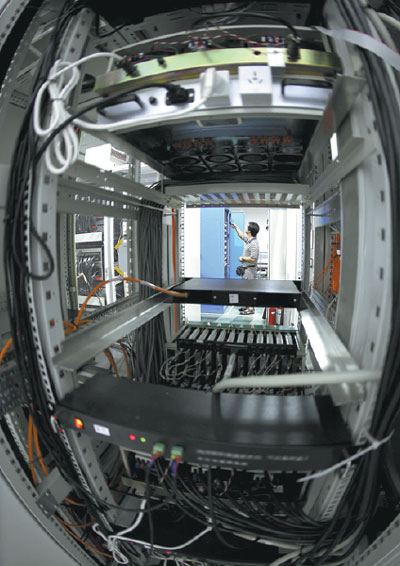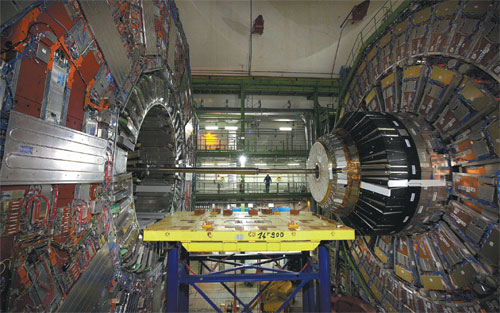Scientists on collision course with future
Updated: 2015-11-18 07:49
By Cheng Yingqi(China Daily USA)
|
||||||||
Chinese physicists have proposed building the world's largest particle collider, making China a global research center. Cheng Yingqi reports.
Many commonplace technologies in our homes and workplaces are the results of less-than-commonplace research.
The World Wide Web, touch-screen technology, diagnostic X-ray equipment and the Linux operating system are examples of relatively recent discoveries that sprang from one of the least-understood branches of scientific research: Particle physics.
Now, with the Beijing Electron Positron Collider, China's 25-year-old particle collider, about five years away from the end of its working life, the nation's high-energy scientists are thinking big and proposing to make the country the center of global high-energy research within the next 10 years.
They have completed an initial conceptual design for a super-giant facility that will be the world's biggest and most powerful particle accelerator and collider.
"We recently completed the initial conceptual design and have organized international peer reviews. The final conceptual design will be completed by the end of 2016," said Wang Yifang, director of the Institute of High Energy Physics at the Chinese Academy of Sciences, in an exclusive interview with China Daily, published on Oct 29.
"The characteristic of high-energy physics is that wherever the most powerful facility is located, that's where the world's leading researchers will be," he said.
If accepted, the designs produced by Wang and his team will significantly upgrade the largest machine on Earth - the Large Hadron Collider of the European Organization for Nuclear Research, also known as CERN.
"When the LHC was started in the 1990s, China's high-energy physics community didn't have the manpower or material resources to offer CERN a lot of cooperation," Wang said.
In July 2012, CERN announced the most significant scientific breakthrough in decades; the discovery of the long-sought Higgs boson particle, also known as the "God Particle", which is crucial to explaining why matter has mass and is seen as a basic building block of the universe. However, China's contribution was once again limited.
An enduring dream
In the 1970s, when European scientists pitched the concept of the Large Electron-Positron Collider - CERN's 27-km-long accelerator chain that preceded the LHC - China wanted a machine of similar scale.
At first, Chinese scientists approached the government with a plan for a collider of 50 gigaelectronvolts - a minute electrical charge roughly equivalent to the amount of energy an ant expends to take one step - known as a proton synchrotron system. The project failed to get off the ground, though, because the experts were "overconfident about the country's economy" at the time, according to Zhang Chuang, a researcher at the Institute of High Energy Physics who participated in the design and construction of the Beijing collider.
In 1980, Deng Xiaoping, China's then-leader, gave special approval for a fund of 240 million yuan ($1.5 million at the time) to build the BEPC. It was a huge amount of money for the impoverished country, but still small when measured against the cost of research.
The limited budget meant the BEPC's designed circumference was only 240 meters, with a maximum energy level of 2.3 GeV, 50 times less than the LEP collider.
Although CERN was dominant in the field, in 2005 Chinese scientists began considering the future of high-energy physics in the country.
"Again and again, we discussed the nature of the machine we would build when the BEPC was decommissioned," Wang said.
In 2009, China invested 640 million yuan to upgrade the collider, and has since spent 90 million yuan annually on its operation and maintenance. Since then, research into low-energy "charm" physics - a form of high-energy physics focused on studying the "charm quark", an elementary particle - has been a unique field for the BEPC, attracting the attention of hundreds of specialists at home and abroad.
However, the low level of energy constrained its capacity for use in the detection of a wider range of novel particles, such as the Higgs boson.
The BEPC and beyond
Despite its limitations, the BEPC helped China train a large number of high-energy physicists, some of whom gained further experience by participating in world-class research projects, such as those carried out at the LHC. "By 2020, the scientific goals of the BEPC will have mostly been achieved, so we will have a group of world-class, high-energy physicists available for the proposed project," Wang said.
The project will have two phases. The first will involve the construction of a 50-to-100-km-circumference Circular Electron-Positron Collider, or CEPC, capable of generating millions of Higgs boson particles, while the second will be a fully updated version of the LHC, but seven times more powerful.
Compared with the LHC - which took 10 years to build and cost several billion dollars - the proposed CEPC, construction of which could begin in 2020 or 2025, has been designed to ensure that the cost will not exceed the European benchmark.
"About 20 percent of the funding for the LHC came from non-European countries. We are also planning to encourage international cooperation in the CEPC, and hopefully 30 percent of the funding will come from overseas," Wang said.
Nima Arkani-Hamed, from the US Institute for Advanced Study in Princeton, New Jersey, said that in addition to providing overseas funding, the international scientific community "will unite to help in the physics and engineering design aspects of putting the CEPC together".
Beneficial spinoffs
So, why would any government spend billions dollars of taxpayers' money on these "big toys" for particle physicists? To satisfy natural curiosity about the origins of the universe or simply to win a few Nobel Prizes?
Those are both credible reasons, but the reality is that the resultant "secondary products" of high-energy research are the driving force.
"In high-energy physics research, there is no existing equipment or methods for us to explore particles about which we know little, so we design and build the equipment ourselves from scratch," Wang said.
That process has resulted in the development of many technologies that have subsequently been applied in wider fields. The World Wide Web is a prime example; in 1989, Tim Berners-Lee, a British scientist working at CERN, invented the Web to facilitate automatic information sharing between CERN scientists in different countries. A few years later, CERN made the software publicly available, thus allowing the growth and development of the Internet.
In China, the construction of the BEPC improved the country's industrial technology and resulted in microwave components and devices that can be applied to radar systems.
Heidi Schellman from Northwestern University in the US, uses the metaphor of climbing Qomolangma, known in the West as Mount Everest, to illustrate the case; the fact that a person is climbing the mountain will not directly affect anyone's daily life, but the fleece jackets and breathable waterproof fabrics that were first invented for serious mountaineering expeditions are now relatively cheap, indispensable and ubiquitous.
Leadership transfer
Despite the short- and long-term benefits that huge scientific projects can bring, the cost of building a super collider is so huge that the world can only afford one at a time.
In the late 1970s, roughly at the same time as the LHC, the US launched an ambitious project in Texas; an 87-km-long collider called the Superconducting Super Collider. However, the project came under fire from the beginning when critics railed against the budget of more than $4 billion.
In 1993, a nonprofit watchdog called the Project on Government Oversight, released a draft audit report that heavily criticized the high cost and poor management, leading the US Congress to officially cancel the SSC in October 1993, even though $2 billion had already been spent.
"The cancellation of the SSC was a disaster for high-energy physics in the US. Overnight, we ceded leadership of a field we had pioneered and driven for decades to Europe," said Arkani-Hamed, who added that the ramifications of the decision continue to be felt.
"Some physicists cynically thought the money for the SSC would go to their favorite areas, but of course nothing of the sort happened. Instead, after the cancellation of the SSC, the US ceased to think of itself as a place where 'really big things can happen'. It has made many of our scientists timid and small-minded in their thinking about the future," he said.
That unfulfilled dream has been adopted by new candidates. CERN is considering a project similar to China's, while Japan is planning an International Linear Collider, which would require more-advanced technology and a much larger budget.
Wang, from the Institute of High Energy Physics, said no matter how fierce the competition, the high cost means there is only likely to be one 100 TeV (trillion electron volts) collider in the world at any given time.
"In the end, it will come down to whose design is best," he said.
Arkani-Hamed believes China can build and operate a massive collider project. "No matter where such a machine happens, developing and building it is going to require a huge influx of new people into the field. China has an ocean of the necessary raw talent needed to make this happen," he said, citing the country's growing economic power and its desire to improve the basic level of research as prime factors.
"There is no other field where leadership can be transferred so decisively, because here the major facility is a discrete unit (a separate entity that's part of a larger whole) and scientists around the world will follow the machine wherever it is," he said.
Contact the writer at chengyingqi@chinadaily.com.cn
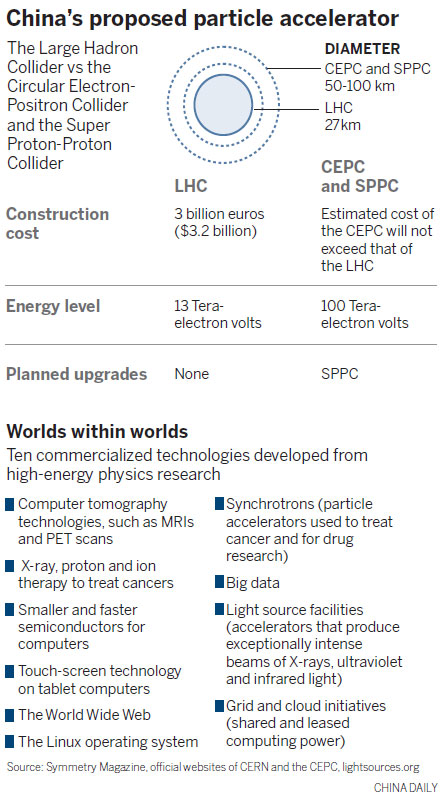
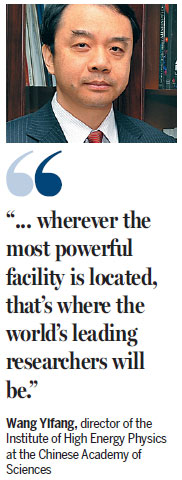
|
A technician performs checks on the Beijing Electron Positron Collider after an upgrade in 2009. Wang Yongji / Xinhua |
|
A view of the Compact Muon Solenoid, one of two particle detectors at the Large Hadron Collider. Hundreds of engineers and staff worked for two years to fit out the giant LHC to facilitate research into elusive sub-atomic particles under the guidance of the European Organization for Nuclear Research. Denis Balibouse / Reuters |
(China Daily USA 11/18/2015 page6)

 Panda cub Bei Bei to make public debut on Jan 16
Panda cub Bei Bei to make public debut on Jan 16
 Landmarks of Paris reopen for tourists after terrorist attacks
Landmarks of Paris reopen for tourists after terrorist attacks
 French warplanes strike Islamic State Syria bastion
French warplanes strike Islamic State Syria bastion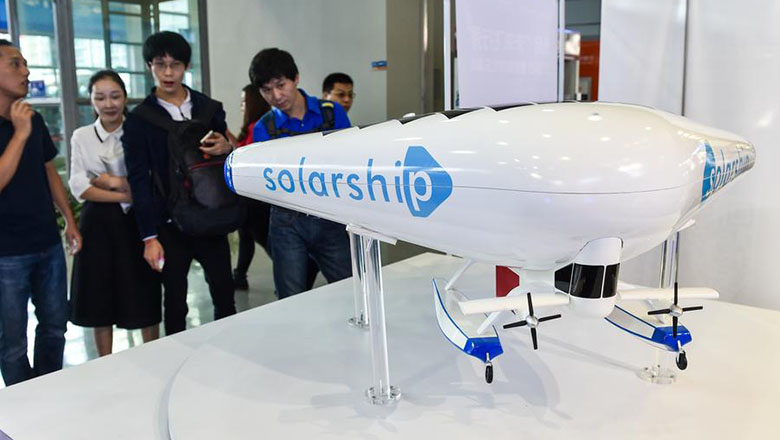
 High-tech fair gears up in Shenzhen
High-tech fair gears up in Shenzhen
 Biggest wild Chinese sturgeon seeks treatment in Beijing
Biggest wild Chinese sturgeon seeks treatment in Beijing
 Tranquility in the ‘Water Forest’
Tranquility in the ‘Water Forest’
 Xi, Putin meet at G20 summit, renewing pledges on cooperation
Xi, Putin meet at G20 summit, renewing pledges on cooperation
 Skimming the surface
Skimming the surface
Most Viewed
Editor's Picks

|

|

|

|

|

|
Today's Top News
Chinese president arrives in Turkey for G20 summit
Islamic State claims responsibility for Paris attacks
Obama, Netanyahu at White House seek to mend US-Israel ties
China, not Canada, is top US trade partner
Tu first Chinese to win Nobel Prize in Medicine
Huntsman says Sino-US relationship needs common goals
Xi pledges $2 billion to help developing countries
Young people from US look forward to Xi's state visit: Survey
US Weekly

|

|
